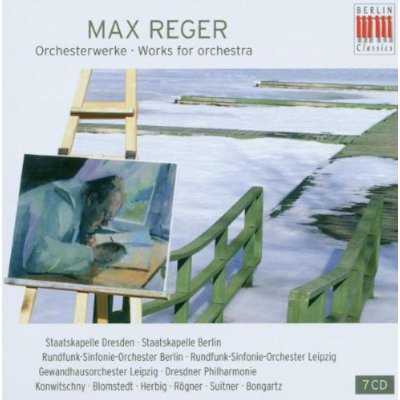
Performer: Amadeus Webersinke
Orchestra: Berliner Staatskapelle, Staatskapelle Berlin, Leipzig Gewandhaus Orchestra, Dresden Staatskapelle, Dresden Philharmonic Orchestra, et al.
Conductor: Otmar Suitner, Franz Konwitschny, Heinz Bongartz, Herbert Blomstedt, Gunther Herbig, et al.
Composer: Max Reger
Audio CD
SPARS Code: A-D
Number of Discs: 7 CD box set
Format: APE (image+cue)
Label: Berlin Classics
Size: 1.68 GB
Recovery: +3%
Scan: yes
CD1
Eine Ballettsuite op. 130 (1913)
Konzert im alten Stil op. 123 (1912)
Beethoven-Variationen op. 86 (1904, 1915)
Karl Suske (violin)
Heinz Schunk (violin) (op. 123)
Staatskapelle Berlin/Otmar Suitner
rec. 1973
CD2
Hiller-Variationen op. 100 (1907)
Gewandhausorchester Leipzig/Franz Konwitschny
rec. 1963
CD3
Mozart-Variationen op. 132 (1914)
Vier Tondichtungen nach A. Böcklin op. 128 (1913)
Walter Hartwich (violin) (Böcklin)
Staatskapelle Dresden/Heinz Bongartz (Böcklin)
Dresdner Philharmonie/Heinz Bongartz
rec. 1970
CD4
Sinfonietta op. 9 (1905)
An die Hoffnung op. 124 (1912)
Hymnus der Liebe op. 136 (1914)
Annelies Burmeister (alto) (opp. 124, 136)
Günter Siering (violin) (op. 9)
Dresdner Philharmonie/Heinz Bongartz (Sinfonietta)
Rundfunk-Sinfonie-Orchester Leipzig/Heinz Bongartz
rec. 1973, 1969
CD5
Violinkonzert A-Dur op. 101 (1908)
Manfred Scherzer (violin)
Staatskapelle Dresden/Herbert Blomstedt
rec. 1984
CD6
Konzert für Klavier und Orchester f-Moll (1910)
Amadeus Webersinke (piano)
Dresdner Philharmonie/Günther Herbig
rec. 1973
CD7
Symphonischer Prolog zu einer Tragödie op. 108 (1908)
Eine romantische Suite op. 125 (1912)
Rundfunk-Sinfonie-Orchester Berlin/Heinz Rögner
rec. 1974
max_reger_works_for_orchestra02.rar – 211.0 MB
max_reger_works_for_orchestra03.rar – 275.6 MB
max_reger_works_for_orchestra04.rar – 324.4 MB
max_reger_works_for_orchestra05.rar – 274.6 MB
max_reger_works_for_orchestra06.rar – 180.7 MB
max_reger_works_for_orchestra07.rar – 224.8 MB
Early Xenakis orchestral music.
This fifth volume in Tympani’s series of CD’s covering Xenakis’ orchestral works includes his earliest works in the medium, all of them top-flight masterpieces. His exploration of music as statistical sound combinations (never “patterns” as there is no overt repetition, the sound being more “sculpted” rather than “stamped out”) was so utterly unheard-of and unique that it rendered his early works well-nigh unintelligible to audiences of the time. There were often riots at his early performances, which ironically helped put him on the map. These works still can shock, fifty years after their premieres! The performances, recordings, liner notes and all are first-rate all around. Kudos to Tympani for bringing this series about.
Thank you very much
Instant grab of an uneven collection. Cf. the two concertos: the impression of the weaker Violin work just running over the dull Piano one through sheer performance strength! But the Hillers are hard to find, as is the Sinfonietta, and they alone weigh up for the entire set. Other means of optimal introduction includes the Cello Solo Suites, Psalm 100, String Quartets 3-5 and Sextet, Piano Trios and Quartets, Violin Sonatas 5 and 8, a cappella Motets, Hebbel Requiem, Latin Requiem fragment (but skip that Kyrie), works for two pianos, two violins, Organ… oh well … –Thank you.
amazing music , i love reger ,thanks man
Thank you very much
WOW!!!
Thanx a lot!!!
;) welcome!
Thanks a lot!
This box set is an ideal beginning for all who wants to become acquainted with a little-known and stronlgly underestimated great composer – Max Reger.
To understand the greatness of Reger’s music is one of the most difficult problems for an amateur of classical music. But the thing is worth the effort!
P.S. After the orchestral music, I recommend to try the solo violin works by Reger (especially Preludes, Fugues and Chaconne – compare them with Bach!). And when you will understand that Clarinet Quintet by Reger is of the same level as Mozart’s and Brahms’, when you will see, how inavoidable all notes in this difficult creation, – after that, I think, you will look for the rest of Reger’s vast output.